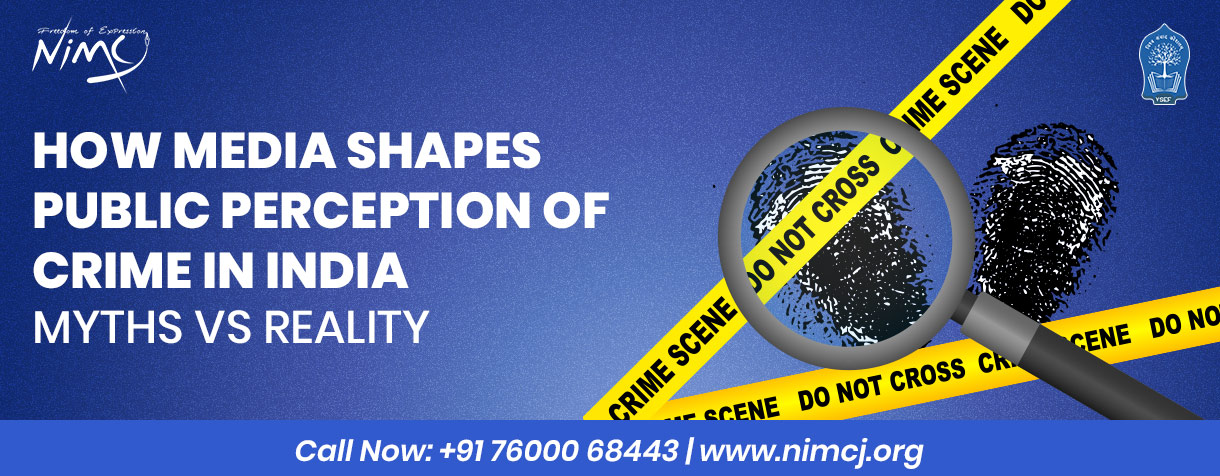
Crime stories sell - but they also shape what we fear, who we blame, and how society responds. In India’s fast-changing media ecosystem, news channels, social platforms, and 24/7 digital outlets don’t just report crime - they help build the public story about it. This blog explains how media influences public perception of crime, separates myths from reality, and uses concrete Indian examples (including cybercrime trends and white-collar scandals) so students and readers understand the stakes.
These rising numbers matter - but how the media reports them often determines public understanding, policy focus, and law-and-order responses.
1. Agenda-setting (what people think about)
Media decides which crimes get coverage. When certain stories (say, a violent crime or a big fraud case) dominate airtime or timelines, the public treats them as priority issues - even if they are statistically rare. This is the classic agenda-setting role of media.
2. Framing (how people think about it)
The angle used - sensational, empathetic, racial/communal, or technical - shapes interpretation. Example: a report that emphasizes “youth gangs” versus one that frames the same incident as socio-economic failure leads to different public reactions.
3. Selection bias & representativeness
Media are more likely to report dramatic, visual, or celebrity-linked crimes. Everyday crimes that affect large numbers (like small-scale frauds or systemic white-collar wrongdoing) may get less attention, skewing perceptions.
4. Sensationalism & emotional amplification
Headlines, clickbait, repeated visuals, and dramatic anchors heighten fear and outrage - sometimes more than the crime itself warrants. This can produce moral panics and pressure on institutions to act quickly.
5. Social media amplification and misinformation
Viral clips, unverified messages on WhatsApp, and short clips on Instagram/TikTok can spread allegations faster than verification - creating “public verdicts” before legal processes conclude.
6. Trial by media
Extensive and biased coverage can prejudice public opinion and, at times, influence legal outcomes - a phenomenon that raises concerns about fairness and due process. Indian courts and commentators have repeatedly flagged “media trials” as problematic when coverage crosses into judgment.
Myth 1 - Crime is rising everywhere and uncontrollably
Reality: Some types of reported crime have risen (notably cybercrime), but crime is heterogeneous - violent crime, property crime, cybercrime, and white-collar crime follow different trends and causes. National reports show increases in certain categories while others decline; regional variation is large. Overgeneralizing creates unnecessary fear.
Myth 2 - Most crime is violent street crime
Reality: In media attention, violent street crimes grab headlines. But white-collar crimes, financial frauds, and cyber frauds can cause far larger economic and social harm - they are underreported in sensational coverage, even though their impacts are huge. See the later section for white-collar case examples.
Myth 3 - Social media is always the best source of truth
Reality: Social platforms rapidly spread claims - but verification is often poor. Viral posts can misidentify suspects, circulate doctored visuals, or present allegations as facts, fuelling rumors and vigilante responses.
Myth 4 - High publicity equals fast justice
Reality: Media attention can speed investigations or force accountability - but it can also pressure authorities into hasty arrests, or conversely, intimidate witnesses and obstruct fair trials (the media trial dilemma).
Cyber crime in India - fastest growing reported threat
Sensational headlines about “hackers” or “data breaches” can create fear; balanced reporting that explains prevention, legal recourse (e.g., NCERT/helplines) and technical fixes is less common but far more useful to the public.
Examples: Satyam (accounting fraud), Nirav Modi/PNB fraud, Harshad Mehta (securities scam), IL&FS (infrastructure finance crisis) - these are high-profile cases commonly referenced as white collar crime in india examples. They involved accounting manipulation, bank fraud, market manipulation and systemic corporate governance failures.
Early stages often receive limited attention compared with violent crime. When they break, coverage can be episodic - sensational at first, then quickly moving on - despite long-lasting systemic effects (jobs lost, investor confidence shaken). Investigative reporting and sustained coverage are essential for public understanding and policy reform.
Real-world examples of media influence
Journalism schools must train students to report crime ethically: balancing the public’s right to know with fairness, teaching data literacy for interpreting NCRB/CERT-In reports, and practising investigative techniques to hold the powerful to account - especially for white-collar and cyber offences that require technical understanding.
At NIMCJ, aspiring journalists learn:
These skills help future reporters explain complex crimes responsibly and reduce harmful myths.
Media shapes not only headlines but public understanding, policy and justice. Responsible reporting and informed audiences are the antidote to sensationalism. In India’s changing crime landscape - with rising cyber crime in India and impactful white collar crime in india examples - the media’s role must be to inform, investigate, and explain - not merely to alarm.
If you’re an aspiring journalist who wants to cover crime - from street level to complex financial fraud - NIMCJ’s BAJMC (Hons.) program trains you in ethics, data journalism, and investigative reporting.
Quick Registration for Admissions
Read Next Blog: What is Investigative Journalism
17 Nov 2025
Post by : NIMCJ